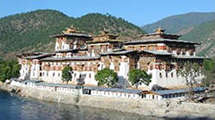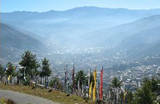|
|
|
Bhutan – Land of the Thunder Dragon, a fairy-tale
brought to life
 The
Himalayan kingdom of Bhutan is know to its people as 'Druk Yul'
which translates to 'the Land of the Thunder Dragon' and is a remarkable
country, with a culture rich in a tradition based on its fundamental
Buddhist faith. Rodney Appleyard
writes with obvious enthusiasm about his visit to Bhutan with Dan
Thory, who has recorded the visit with some beautiful photography. The
Himalayan kingdom of Bhutan is know to its people as 'Druk Yul'
which translates to 'the Land of the Thunder Dragon' and is a remarkable
country, with a culture rich in a tradition based on its fundamental
Buddhist faith. Rodney Appleyard
writes with obvious enthusiasm about his visit to Bhutan with Dan
Thory, who has recorded the visit with some beautiful photography.
'The Lion, The Witch and the Wardrobe' is still to
this day one of my favourite children's books. I will never forget
the moment when the children first step into the wardrobe and magically
appear inside the land of Narnia. I often imagined what it would
be like to do this, and I can remember trying to walk through wardrobes
myself as a small child. Well, after visiting Bhutan, I think that's
the closest I will ever finding a land with such a fairytale presence.
Bhutan is full of magical legends, breathtaking scenery,
unspoilt land, uniquely crafted architecture and probably the most
gentle people on earth. There is hardly any crime because the people
believe so strongly in Buddhism. The nation has a population of
about 650,000, and most of these people live in the rural areas.
This is a very small population, considering Bhutan is about the
same size of Wales. More than 70 per cent of the land is covered
by beautiful forests, which the Bhutanese have actively protected.
 The
Bhutanese people have kept themselves in isolation for centuries,
but recently they have taken major steps towards modernisation,
initiated by their King, Jigme Singye Wangchuck. Tourists have only
been allowed into the country since 1974, when the King had his
coronation. Since then, they have embarked on an experiment which
involves preserving the best aspects of their traditional culture,
whilst incorporating the most attractive elements of the Western
world, such as television and the internet (which they started in
1999), albeit at a level which enriches the country instead of damaging
it. The
Bhutanese people have kept themselves in isolation for centuries,
but recently they have taken major steps towards modernisation,
initiated by their King, Jigme Singye Wangchuck. Tourists have only
been allowed into the country since 1974, when the King had his
coronation. Since then, they have embarked on an experiment which
involves preserving the best aspects of their traditional culture,
whilst incorporating the most attractive elements of the Western
world, such as television and the internet (which they started in
1999), albeit at a level which enriches the country instead of damaging
it.
The King has told his people that he cares more about
'Gross National Happiness' than 'Gross National Product'. This means
that they will not rush towards modernisation, as tends to be the
obsession in the rest of the developing world. Instead, he aims
to improve the living standards of his people at a pace which serves
their well-being first and improves the national economy second.
Bhutan – a magical country
So what are the traditional values which makes this country seem
so magical, unreal, unique, spellbinding and unforgettable? Well,
there are the legends of some of the ancient Buddhas and Saints,
whose achievements would have made even Aslan proud. People still
believe and talk about The Buddha Padmasambhava who, in the 8th
century, fled Tibet on the back of a tigress and flew to a place
in Bhutan called Paro where he slayed an evil monster. At this very
spot, 3,000 feet up a cliff, the Takstang Goemba Monastery was built
at the foot of the rock face. It is now called 'TigerŐs Nest' and
many monks spend 3 years, 3 months and 3 weeks meditating at this
Monastery to show their dedication to their religion.
Then there are the humorous stories from the 15th
century, of the' Divine Madman' – Saint Lama Drukpa Kunley
– who is still greatly respected. He was responsible for slaying
demons with his his sexual organ, which he used as a sword. His
phallus is still painted on buildings throughout the country as
people hope this will bring increased fertility to their family.
The Lama had a problem convincing people of his supernatural powers
so, legend has it, one day he ate flesh from the head of a goat
and the body of a cow and then stuck the head of the goat onto the
body of the cow to create a creature called a takin. The takin,
an extremely rare bovid, is now the national animal of Bhutan and
can be found in herds at very high altitude.
 Tradition
and nature in Bhutan Tradition
and nature in Bhutan
ItŐs amazing how well ordered, passive and religious the people
of Bhutan are. They clearly enjoy preserving their national culture
and heritage, and seem proud to wear their stunning National Dress.
Religion is such a strong part of this country that it is closely
interwoven with politics, ensuring that policies follow the Buddhist
way of life.
Most visitors to Bhutan are taken on guided tours
to wonderful places such as Phuntsholing, Paro, Punakha, Tongsa
and Bumthang. These places boast untouched rivers, lush forests,
glorious hill views which stretch out for miles and join up with
snow-capped mountains in the distance. It is common to notice natural
springs jetting out of the valleys sides and come crashing down
on rocks scattered below. There seems to be a powerful feeling of
the closeness nature everywhere you go – the Bhutanese people
used to worship the mountains and the valleys, so this explains
why they are so well cared for.
 Apart
from the natural environment, many of the buildings are awe-inspiring
too. The monasteries and government buildings are called Dzongs.
Bhutan has a policy of not erecting any buildings more than four
stories high and new buildings have to be decorated with the traditional
Bhutanese designs. Apart
from the natural environment, many of the buildings are awe-inspiring
too. The monasteries and government buildings are called Dzongs.
Bhutan has a policy of not erecting any buildings more than four
stories high and new buildings have to be decorated with the traditional
Bhutanese designs.
The whole of Bhutan feels like a real-life fairy tale
where you can find paradise in the culture and environment. It might
be an expensive destination, but it's worth every penny!
Text © Rodney Appleyard,
photographs © Dan Thory, 2003
|
FACT FILE – Visiting Bhutan
By restricting entry by the use of tourist visas, Bhutan strictly
limits the number of people who can visit the country in a
single year and all visitors are charged for tourism services
(guides, transport, hotels, meals, etc.) at a fixed daily
rate. This is deliberate policy by the Bhutanese government,
designed to keep visitor numbers to a level which does not
significantly affect the natural environment or lifestyle
of the Bhutanese people. The Bhutanese tourism industry is
founded on the principle of sustainability; tourism must be
environmentally and ecologically friendly, culturally and
socially acceptable, and economically viable.
Entry to Bhutan is by visa
and is usually, but not exclusively, for organised groups.
For the average tourist this is generally the best way to
see the country and we have started a list of contacts for
such companies below (we will be adding to this on a regular
basis as new tour operators join our listings).
The following companies
are already listed in the travel-quest directory:
Lingkor Tours
& Treks
Snow
White Tours
Tenzing
Norgay Adventures
Trans
Himalaya
|
|

